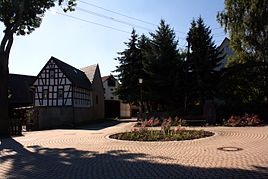Schelditz
|
Schelditz
community Rositz
Coordinates: 51 ° 0 ′ 36 ″ N , 12 ° 22 ′ 55 ″ E
|
||
|---|---|---|
| Height : | 188 m above sea level NN | |
| Incorporation : | July 1, 1950 | |
| Postal code : | 04617 | |
| Area code : | 034498 | |
|
Location of Schelditz in Thuringia |
||
|
Center of the old town center
|
||
Schelditz is a district of the municipality of Rositz in the Altenburger Land district in Thuringia .
location
The district of Schelditz is located in the south of the municipality of Rositz on Kreisstraße 223 and Landesstraße 1361. The district is in Altenburger-Zeitzer-Lösshügelland on the southern edge of the Leipzig lowland bay . Schelditz is located on the Gerstenbach , which flows into the Pleiße near Serbitz .
history
Schelditz was first mentioned in a document in the period 1181–1214. a. as "Scelditz" in the tithe directory of the Bosau monastery from 1181. The Sorbian name means "place of servants and servants". A Reichsministerial Gerard von Scelditz is mentioned around 1210 . His descendant Conrad von Scelditz sold his possessions in Schelditz to the Teutonic Order House in Altenburg in 1282 . Unlike the other Schelditzer farmsteads that since the 16th century was existing Freigut not burdened with compulsory labor. From 1594 it belonged to the electoral cavalry master of Dresden, Tilo von Osterhausen. Since 1676 the gentlemen from Stange zu Oberlödla were on the estate. The Altenburg castle captain Friedrich Wilhelm von Stange sold the estate to Georg Zetzsche from Kriebitzsch in 1724 . His descendant, the freehold owner Hermann Zetzsche, sold the site with a brick factory built at the time to Albin Taubert from Zechau in 1882 . Albin Taubert's son Max sold it with all of the buildings to the DEA mineral oil works at the beginning of the 20th century .
In terms of administration, Schelditz belonged to the Wettin office of Altenburg , which was under the sovereignty of the following Ernestine duchies from the 16th century due to several divisions in the course of its existence : Duchy of Saxony (1554 to 1572), Duchy of Saxony-Weimar (1572 to 1603), Duchy Saxe-Altenburg (1603 to 1672), Duchy of Saxe-Gotha-Altenburg (1672 to 1826). When the Ernestine duchies were reorganized in 1826, the place came back to the duchy of Saxony-Altenburg. After the administrative reform in the duchy, Schelditz belonged to the eastern district (until 1900) and to the Altenburg district office (from 1900). From 1918 the village belonged to the Free State of Saxony-Altenburg , which was added to the State of Thuringia in 1920. In 1922 it came to the district of Altenburg .
On April 1, 1923, Schelditz was incorporated into Rositz despite protests such as Gorma and Fichtenhainichen . After examination by the authorities of the state of Thuringia, Schelditz initially became independent again on August 1, 1924. Schelsitz was finally incorporated into Rositz on July 1, 1950. Detailed information on the further development of the village is given in the literature and in the main article Rositz .
Lignite mining
In Schelditz that the east of the Meuselwitz-Rositzer coal mining area is located, lying was in the west of the town underground mine "New Rositz no. 145" from 1917 to 1942 coal mined. The history of the place was significantly influenced by the opening of the DEA mineral oil works (Rositzer Teerwerke) directly northeast of the place in the corridor of Fichtenhainichen in 1917 .
During the Second World War , one of eight camps for slave labor was located in Schelditz, in which more than a thousand slave laborers had to work: for Deutsche Erdöl AG (DEA) , for the Rositzer sugar refinery , at the company K. Eisenrieth , for the Rositzer Coal works and for the Curt Plützsch company .
In 1945 the Allied bombardment of the Rositzer tar factory caused severe damage in neighboring Schelditz. The contaminated sites of the factory, which was still in operation during the GDR era, contaminated the rising groundwater as a result of the closure of lignite mining. Security measures have been planned since 2014.
In the 1980s, it was planned to resume lignite mining in the Meuselwitz-Rositzer lignite district, but this was not carried out. A large part of the municipality of Rositz including part of Schelditz without the neighboring refinery would have had to give way to the planned “open-cast mine Meuselwitz” between Meuselwitz and Rositz.
Individual evidence
- ^ Wolfgang Kahl: First mention of Thuringian towns and villages. A manual. Verlag Rockstustuhl, Bad Langensalza, 2010, ISBN 978-3-86777-202-0 , p. 247
- ^ The Altenburg Office in the book "Geography for all Stands", from p. 201
- ↑ The locations of the Altenburg district from p.83 ,
- ↑ The eastern district of the Duchy of Saxony-Altenburg in the municipal directory 1900
- ^ The Altenburg district office in the municipality register 1900
- ^ The place on the website of the community Rositz.Retrieved on June 16, 2013
- ↑ Schelditz on the website of the municipality of Rositz.Retrieved on August 27, 2012
- ↑ Thuringian Association of the Persecuted of the Nazi Regime - Association of Antifascists and Study Group of German Resistance 1933–1945 (ed.): Heimatgeschichtlicher Wegweiser to places of resistance and persecution 1933–1945, series: Heimatgeschichtliche Wegweiser Volume 8 Thüringen, Erfurt 2003, p. 24f ., ISBN 3-88864-343-0
- ^ Ostthüringer Zeitung , November 20, 2014
- ↑ The Altenburg / Meuselwitz lignite district, LMBV publication
Web links
- History of Schelditz on the Rositz website
- Description of the Meuselwitz-Rositzer lignite district in a PDF document from the LMBV


